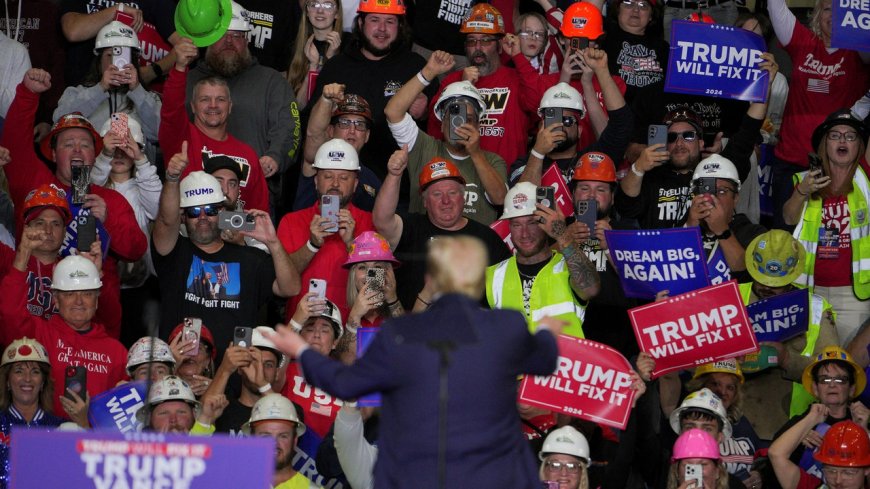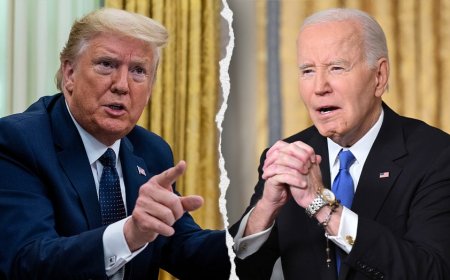How Donald Trump Gave Democrats the Working-Class Blues
The LedeKamala Harris spoke of creating an “opportunity economy,” a vague idea more likely to appeal to entrepreneurs than to struggling workers.By Eyal PressNovember 16, 2024Photograph by Jeenah Moon / REUTERSIn July, 2016, at the Democratic National Convention, in Philadelphia, Senator Chuck Schumer was asked whether he thought that, in the coming election, the anxiety about wages and jobs among working-class voters in states like Pennsylvania might benefit Donald Trump. Schumer dismissed the concern. “For every blue-collar Democrat we will lose in western P.A., we will pick up two, three moderate Republicans in the suburbs of Philadelphia, and you can repeat that in Ohio and Illinois and Wisconsin,” he said.The election exposed the fallacy of his assumption. That November, Hillary Clinton won a majority of voters with college degrees. It wasn’t enough in places like Wisconsin and Pennsylvania, where Trump prevailed among the far larger pool of voters without such degrees—the welders, truck drivers, and factory workers who for several generations had formed the base of the Democratic Party, back when it was known for championing what F.D.R. called “the forgotten man.” Once in office, Trump rewarded the workers who had supported him by weakening labor protections and giving tax cuts to the rich. But his victory underscored the potency of his xenophobic brand of right-wing populism, which was fuelled by resentment toward élites and by frustrations simmering in communities whose working-class residents felt left behind.By the time Kamala Harris delivered her acceptance speech at the Democratic National Convention this past summer, the risk that Trump might once again exploit the grievances of working-class voters to win the Presidency was clear. In a Gallup poll conducted in August, sixty-three per cent of respondents said that the economy was getting worse, more than double the number that said it was improving. Although the stock market was booming, a few years of high inflation had caused President Biden’s approval numbers to plummet and left many voters dissatisfied with the status quo. The fact that Harris had served in the Administration that presided over this period put her at a distinct disadvantage. Her race and gender were additional impediments, exposing her to the racism and misogyny that Trump rarely missed an opportunity to stoke.Overcoming these factors would have been a daunting challenge even if Harris had run a flawless campaign. Yet she also made some decisions that did little to help her cause. To defeat Trump, she needed to present a compelling alternative to his economic agenda. No such alternative emerged. Instead, Harris promoted an incoherent mix of progressive policy measures—an expanded child tax credit, grants of twenty-five thousand dollars for people seeking to buy their first homes—and ideas favored by Wall Street, such as a much gentler increase in taxes on long-term capital gains for millionaires than Biden had proposed. At campaign rallies, her running mate, Governor Tim Walz, portrayed her as a principled crusader who had “stood up against powerful corporate interests” since her days as a district attorney in California. In her speeches and interviews, Harris struck a more business-friendly tone, vetting ideas with executives including her brother-in-law Tony West, who advised her, having taken leave as Uber’s chief legal officer. She ran on “joy,” even as a Pew survey conducted last year found that just four per cent of Americans felt excited when they thought about politics. Among the tens of millions of workers whose wages have not kept pace with the cost of living in recent years, there has been far more frustration than joy.Back in 2016, the blue-collar voters who supported Trump hailed mainly from the white working class, leading some analysts to attribute his victory to racial resentment rather than economic duress. This time, Trump won nearly two-thirds of all voters without college degrees, and improved his performance with the nonwhite working class. According to exit polls, his support among Black men rose by more than a third. He also won a large share of Latinos, who appeared to trust him more on the economy, which polls showed was by far the most important issue to Latino voters. In places like Reading and Allentown, cities in Pennsylvania with large Latino populations, Harris might have been able to prevent this from happening by speaking more forcefully about the need to give working people a raise. The minimum wage in Pennsylvania is $7.25 an hour, forcing residents of cities like Reading to hold down multiple jobs to get by. Campaigning loudly on a pledge to double the federal minimum wage to fifteen dollars an hour likely would have drawn their attention, a group of voter-registration workers I met with on a visit to Reading in August told me. Yet Harris barely mentioned the issue during her campaign.The Vice-President did fare well among some members of


Kamala Harris spoke of creating an “opportunity economy,” a vague idea more likely to appeal to entrepreneurs than to struggling workers.
In July, 2016, at the Democratic National Convention, in Philadelphia, Senator Chuck Schumer was asked whether he thought that, in the coming election, the anxiety about wages and jobs among working-class voters in states like Pennsylvania might benefit Donald Trump. Schumer dismissed the concern. “For every blue-collar Democrat we will lose in western P.A., we will pick up two, three moderate Republicans in the suburbs of Philadelphia, and you can repeat that in Ohio and Illinois and Wisconsin,” he said.
The election exposed the fallacy of his assumption. That November, Hillary Clinton won a majority of voters with college degrees. It wasn’t enough in places like Wisconsin and Pennsylvania, where Trump prevailed among the far larger pool of voters without such degrees—the welders, truck drivers, and factory workers who for several generations had formed the base of the Democratic Party, back when it was known for championing what F.D.R. called “the forgotten man.” Once in office, Trump rewarded the workers who had supported him by weakening labor protections and giving tax cuts to the rich. But his victory underscored the potency of his xenophobic brand of right-wing populism, which was fuelled by resentment toward élites and by frustrations simmering in communities whose working-class residents felt left behind.
By the time Kamala Harris delivered her acceptance speech at the Democratic National Convention this past summer, the risk that Trump might once again exploit the grievances of working-class voters to win the Presidency was clear. In a Gallup poll conducted in August, sixty-three per cent of respondents said that the economy was getting worse, more than double the number that said it was improving. Although the stock market was booming, a few years of high inflation had caused President Biden’s approval numbers to plummet and left many voters dissatisfied with the status quo. The fact that Harris had served in the Administration that presided over this period put her at a distinct disadvantage. Her race and gender were additional impediments, exposing her to the racism and misogyny that Trump rarely missed an opportunity to stoke.
Overcoming these factors would have been a daunting challenge even if Harris had run a flawless campaign. Yet she also made some decisions that did little to help her cause. To defeat Trump, she needed to present a compelling alternative to his economic agenda. No such alternative emerged. Instead, Harris promoted an incoherent mix of progressive policy measures—an expanded child tax credit, grants of twenty-five thousand dollars for people seeking to buy their first homes—and ideas favored by Wall Street, such as a much gentler increase in taxes on long-term capital gains for millionaires than Biden had proposed. At campaign rallies, her running mate, Governor Tim Walz, portrayed her as a principled crusader who had “stood up against powerful corporate interests” since her days as a district attorney in California. In her speeches and interviews, Harris struck a more business-friendly tone, vetting ideas with executives including her brother-in-law Tony West, who advised her, having taken leave as Uber’s chief legal officer. She ran on “joy,” even as a Pew survey conducted last year found that just four per cent of Americans felt excited when they thought about politics. Among the tens of millions of workers whose wages have not kept pace with the cost of living in recent years, there has been far more frustration than joy.
Back in 2016, the blue-collar voters who supported Trump hailed mainly from the white working class, leading some analysts to attribute his victory to racial resentment rather than economic duress. This time, Trump won nearly two-thirds of all voters without college degrees, and improved his performance with the nonwhite working class. According to exit polls, his support among Black men rose by more than a third. He also won a large share of Latinos, who appeared to trust him more on the economy, which polls showed was by far the most important issue to Latino voters. In places like Reading and Allentown, cities in Pennsylvania with large Latino populations, Harris might have been able to prevent this from happening by speaking more forcefully about the need to give working people a raise. The minimum wage in Pennsylvania is $7.25 an hour, forcing residents of cities like Reading to hold down multiple jobs to get by. Campaigning loudly on a pledge to double the federal minimum wage to fifteen dollars an hour likely would have drawn their attention, a group of voter-registration workers I met with on a visit to Reading in August told me. Yet Harris barely mentioned the issue during her campaign.
The Vice-President did fare well among some members of the working class. According to exit-poll data, she won voters from union households by an eighteen-point margin in Michigan and by nine points in Pennsylvania. These results owed, in no small part, to the policies of the Biden Administration, whose staunch support for unions and ambitious legislative agenda—the Inflation Reduction Act, the CHIPS and Science Act—generated a surge in domestic manufacturing and clean-energy production that has created hundreds of thousands of quality jobs. Biden’s tenure marked a significant break from an era when the Democratic Party seemed to take the support of organized labor for granted, passing free-trade agreements that decimated many factory towns and angered a lot of rank-and-file workers. But, as the political philosopher Michael Sandel has noted, Biden failed to connect his economic policies to a larger governing project, akin to F.D.R.’s New Deal. In some states, workers who directly benefitted from the President’s policies were not even aware that the jobs and investments flowing into their communities came from legislation he’d signed.
Instead of explaining how she would build on Biden’s accomplishments and tackle corporate greed and inequality, Harris spoke of creating an “opportunity economy,” a vague idea more likely to appeal to entrepreneurs than to struggling workers. What Trump will offer these workers is hardly better, some might note. He has claimed that his plan to impose steep tariffs on trillions of dollars of imports will instantly bring factories back to the U.S. “They’ll come right away,” he said. Few economists agree, warning that following through on this pledge will instead cause consumer prices to rise, with the heaviest burdens falling on low-income families.
Trump’s plan to close the border and undertake mass deportations is equally unlikely to help workers in places like the Monongahela Valley, a center of Pennsylvania’s once thriving steel industry. But assuming that the workers Trump disappoints will eventually come back to the Democratic Party without giving them a compelling reason to do so is as delusional as thinking that losing their support can be offset by tacking to the center and courting Republicans in the suburbs. “Democrats have to develop a real economic brand that people know and feel will help working families,” Celinda Lake, a pollster who has done extensive surveys of working-class voters, said. “Right now, people think Democrats have no economic plan.” As misguided as Trump’s vision for the working class may be, at least he has one, Lake noted, “and you can’t beat something with nothing.” ♦


























































